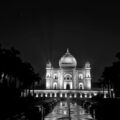The magnificence of Mughal Architecture is witnessed in all its glory across New Delhi. A unique style the encapsulates the aura of India’s rich past, the tombs, mosques, and forts make for an exciting history lesson filled with stories of love, tragedy, and betrayal. Simultaneously, it shines a spotlight on the art and culture from the time.
Built-in 1569-70, Humayun’s Tomb is the final resting ground of the Mughal Emperor Nasir-ud-Din Muhammad popularly known as Humayun. The son of Babur, Humayun ruled over the Mughal empire for a decade from 1530 starting at a young age of 23. He then lost command to Sher Shah Suri only to return and win back his kingdom in 1555.



Humayun’s first wife, Bega Begum, also buried in the same complex, ordered the building of the monument. At that time, it was situated on the banks of the river Yamuna. And at present, it is supposed to have close to 100 graves of various noblemen and rulers.
Legend has it that the grave of Dara Shukoh is situated here. The eldest son of Emperor Shah Jahan, he was killed by his younger brother Aurangzeb and buried in an unmarked grave.




A UNESCO World Heritage Site, the Mukhbarae-e-Humayun is the first garden-tomb to have been built in this region. Its Persian inspired architecture predates the Taj Mahal, and similarities can be seen between the two regarding the construction and structure.
Another speciality of the tomb is the red sandstone, used in such an extensive way for a monument of this nature. Marble and the red sandstone gives the building a very regal appearance, even after the passing of hundreds of years.
Moreover, it follows the architectural style of char-bagh (four gardens), connected with pathways, water streams and fountains along the way. This is still is a sense of opulence and lavishness associated with the vast expanse of land that surrounds the main building, fit for kings.




Another prominent tomb in the complex is that of Isa Khan. A member of Sher Shah Suri’s court, he was a nobleman of the highest order. His octagonal tomb, surrounded by an octagonal garden, follows a distinct style of architecture that is in contrast to Humayun’s Tomb.
The entire complex was under renovation during the earlier half of the decade. During this time, it was meticulously refurbished to reflect some of its past glory.



Tips:
Humayun’s Tomb is one of the most photographed locations in Delhi and can get busy, though not crowded, throughout the day.
Although the complex has a distinct charm, no matter the season, the harsh light of the summer sun can often make photography a pain. So avoid visiting the tomb, if that is your primary reason for a visit.

An entry fee of Rs 30 for Indian and SAARC member as well as Rs 500 for foreign visitors is applicable at the entrance.
Unlike a lot of monuments in India, they do not have any separate fee for taking a camera (DSLR, Phone, GoPro). Nor was there any issue with taking photos. However, if you need to take video equipment, then I believe permission is required.

The area is clean, and there are benches as well as shaded areas where one can rest a while or have a lovely little picnic.
I saw many gardeners making sure the lawns are tidy and well kept.
There is some walking involved, so do wear good comfortable shoes when visiting the complex.
Make sure you keep aside a good 2-3 hours to explore and appreciate all the monuments in the complex which are true architectural marvels in their rights.







18 Comments
arv!
I love the GoPro shot which lend a new perspective with extra-wide capture!
Ticker Eats The World
Thank you. Surprisingly it has become a favourite for still photography.
arv!
I’m not surprised, Raghav! 🙂
Steps Together
Absolutely beautiful post with amazing captures. Brought back memories of our last year’s visit to this marvel. Thank you.
Ticker Eats The World
Thank you so much and glad it brought back some good memories.
Sachin Baikar
Informative post with beautiful photos 👍 Raghav. Thanks for sharing 🙂
Ticker Eats The World
Thank you so much.
dNambiar
What a great specimen of Mughal architecture. Aren’t we glad these tombs are open to the public.
Exceptional photography, Raghav.
Ticker Eats The World
Thank you so much and yes. I am also glad that some measures are being taken to restore them. However, there are so many more monuments all around Delhi, it would be nice to see all of them get the same attention.
vinneve
Beautiful architectures!
ania
they are magnificent, im impressed
Ticker Eats The World
Thank you.